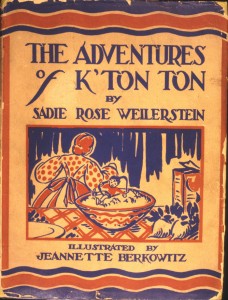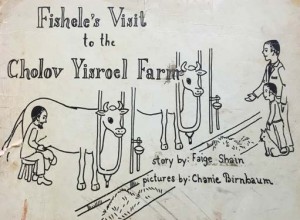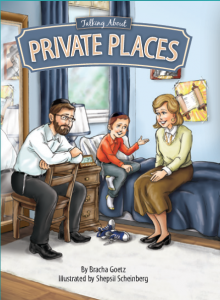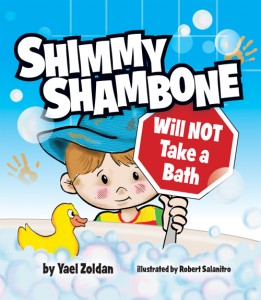The State of Orthodox KidLit

The Adventures of K’tonton by author Sadie Rose Weilerstein. Courtesy of The Jean Sorkin Moldovan Collection, a collection of Yeshiva University Museum
When I was growing up, the only children’s books available in a Jewish bookstore were a small selection of English-language Jewish-oriented morality tales. Books such as the sweet handwritten and spiral-bound Fishele and Fraydele series or the memorable Dov Dov series taught us much about listening to our parents, cleaning our rooms and always being ready on time for Shabbos. Readers of a certain age may also fondly remember a few classic Jewish children’s books, such as K’tonton, a delightful series (1930) that centered on the escapades of a thumb-sized boy; The All-of-a-Kind Family series (1951), which featured five sisters living on the Lower East Side at the turn of the century and The Carp in the Bathtub, a charming story (1987) that portrayed the thrill of Pesach preparations as seen through a child’s eyes.
But while these works were wholesome, enjoyable and rich with Jewish themes, they were practically the only such books around.
Well, we’ve certainly come a long way. The Orthodox children’s book market has exploded in recent years, with new publishers, authors and books appearing each year. According to book publicist and book shepherd Stuart Schnee, these days, more children’s titles are being released by Orthodox publishers than ever before.
Today, Jewish bookstores across the country are packed with children’s books catering to every age, from toddlers to young adults, on every imaginable topic and genre including fiction, historical fiction, non-fiction and biographies. Visually, Jewish books are light years ahead of where they were a few decades back. Modern picture books with religious themes geared for toddlers and preschoolers are filled with bright, bold colors and eye-catching illustrations. Perhaps even more surprising is the wonderful array of graphic novels/comics catering to tweens and young teens.
Evolution of an Industry
Children’s book author Yaffa Ganz is a pioneer in the world of Jewish children’s books. The author of the Savta Simcha series (Feldheim, 1980) as well as the Mimmy and Simmy series (Feldheim, 1985) and more than forty-five other Jewish books, she famously started writing because there just wasn’t much for her children to read. “Once upon a time,” she recalls, “everything was done by hand. It was a long, laborious process so publishers were very fussy about what they printed.”
Similarly, Goldie Golding, author of Arrogant Ari Learns A Lesson (Mesorah, 1988) and Eli and his Little White Lie (Mesorah, 1989) remembers that in the late 1980s, ArtScroll was thrilled to publish her stories because there were so few Jewish children’s books available at the time.

Fishele’s Visit to the Cholov Yisroel Farm by author Faige Shain. Illustrations courtesy of Yael Zoldan
“There was a handful of women writing [in the early 80s]—Sheindel Weinbach, Yaffa Ganz,” recalls Miriam Zakon, editor at Targum Press and author of numerous books including Gemarakup Super Sleuth, a mystery series for middle schoolers (Mesorah, 1990). “Okay, less than a handful!” When Zakon started writing back then, “Novels, young adult books, children’s illustrated books, self-help—these genres hardly existed.”
Indeed, in the ensuing decades, Orthodox publishers began to recognize the need for high-quality, entertaining books that reflect Orthodox values—books that engage kids and, at the same time, reinforce the frum lifestyle by centering on themes such as the yamim tovim, the prayers and various mitzvot.
“We were a new generation of native English speakers who had grown up on secular literature and Torah values, and . . . we realized it was time for a synthesis of the two,” says Zakon. “It helped that the mores and ethics and even the language of both children’s and adult literature were becoming more and more at odds with Torah values.”
Remarkably, Jewish children’s publishing has managed to stay relevant in our high-tech, digital-obsessed world. Even with technology serving as a formidable competitor for kids’ attention, frum book sales have not suffered. In fact, while a 2010 Kaiser Family Foundation study found that the average eight to ten year old spends nearly eight hours a day with a variety of different media—and older children and teenagers spend more than eleven hours per day—rather than seeing a diminishment in Orthodox children’s book publishing, production is booming. Dovid Schulman, manager at Eichler’s Judaica in New York City, estimates that in just the past three years, the quantity of children’s books released has increased by 5 percent, and that figure is growing by the year. “Before Rosh Hashanah alone, we had fifteen new children’s books come out. Can you imagine what we see over the course of an entire year?” Danny Levine, owner of J. Levine Books & Judaica in Manhattan, estimates that some 100 new Jewish children’s titles appear each year.
Remarkably, Jewish children’s publishing has managed to stay relevant in our high-tech, digital-obsessed world.
What Appeals to Kids
Devorah Leah Rosenfeld, publisher at Hachai Publishing and author of Labels for Laibel (Hachai, 1990) and A Chanuka Story for Night Number Three (Hachai, 2009) sees advances in the overall state of Orthodox children’s books. She credits the improvements to the community’s deeper understanding of child psychology and development. Publishers, she says, have a better understanding of what appeals to kids.
“In the beginning, there was a gap between what teachers and mothers knew to be age-appropriate for children, and what Jewish publishers were producing,” says Rosenfeld. “The first book dummy I submitted was questioned. The publisher wondered, ‘Who will pay for an entire page with so few words on it?”’
 She notes that even books geared for older kids contain more sophisticated storylines and themes. “There are more problem novels for older readers, and more titles about difficult subjects for the picture book set. It’s a positive development, and these books are a springboard for important discussions.”
She notes that even books geared for older kids contain more sophisticated storylines and themes. “There are more problem novels for older readers, and more titles about difficult subjects for the picture book set. It’s a positive development, and these books are a springboard for important discussions.”
Schnee agrees that the themes found in Orthodox kids’ books have expanded to include topics that were once considered taboo, including ADHD, special-needs siblings, avoiding abuse and bullying. In this sense, children’s books are a litmus test, reflecting what our community is thinking about and dealing with.
In fact, a quick scan of the shelves at a local Jewish bookstore reveals titles such as My Friend the Bully, Let’s Stay Safe (with information about appropriate and inappropriate touching) and Talking about Private Places. While it’s painful to think that some of these issues exist in our community, it’s a healthy sign that that they are being addressed.
What Doesn’t Appeal
There is no such thing as a “children’s book,” contended famed writer J. R. R. Tolkien. He argued that books that capture children’s imagination aren’t “children’s books”; they are simply good books. With this standard in mind, do the books available in the Orthodox children’s market qualify as good books?
Some critics have noted that while increased production in Orthodox children’s publishing has resulted in an abundance of attractive, entertaining books, the quality has not quite kept up.
In discussions with frum children’s authors, a few have confessed to feeling frustrated with publishers who shy away from content that might be perceived as “controversial.” Thus, storylines in which kids do not exemplify sterling middot are often rejected. Such guidelines can be very restricting for authors, and can result in flat plots and one-dimensional characters.
“Publishing is a business and publishers have to produce books. Therefore they try to sell books that are glatt mehadrin in order to garner the largest number of readers,” says Ganz. “But not everyone defines glatt mehadrin in the same way and it’s often difficult to make everyone happy.”
“There are many lovely books out there, but still not enough creative, thought-provoking, fun books,” she adds. “Most are ‘how-to’ books—how to be good Jewish boys or girls. They’re fine as educational books but they don’t necessarily speak to the imagination or invite creativity.”
Listen to Yael Zoldan discuss the growth of literature for Orthodox Jewish children at https://www.ou.org/life/arts-media/savitsky_zoldan.
Golding, who in addition to being a children’s author is the director of the Preschool Department at Yeshivat Shaare Torah in Brooklyn, insists that “there can never be enough books that deal with social-emotional issues, making friends and other topics concerning bein adam l’chaveiro [interpersonal issues]. But the writing needs to be really good. Instead of telling kids what to do, parents can discuss [such issues] through a story and use that as a jumping point.”
She notes that frum books geared for preschoolers tend to be overly didactic. Her advice for children’s authors: “Don’t hit kids over the head with the message. Let the children figure out by themselves what it means to be a good friend, how to problem solve. And use vocabulary that doesn’t talk down to them. They can [come across] a hard word once in a while!”
Still others feel that the books are not diverse enough and do not represent the broad spectrum of Orthodox families. Chava Pinchuck, past chair of the Sydney Taylor Book Awards, says we need books with “illustrations that depict Sephardim, and men and women with less of a ‘Yeshivish’ look to them.” There are different ways to be an Orthodox Jew and many more of them should be shown in the books we give to children, she says.
Schnee agrees. “If you look at older Yaffa Ganz classics, the characters are clearly Orthodox Jews but there are less visible signs of group belonging.”
Creating compelling literature for the young adult crowd is another formidable challenge. “We need more intelligent young adult novels, on the level of books like The Giver or The Hunger Games,” says Zakon. “They don’t have to be edgy, but I’d like to see some with serious themes that take on young people’s views of life. My experience is that little kids are still reading the Jewish illustrated books, but as they get older they turn to secular literature.”
Adolescent boys, in particular, are a neglected demographic, says Chaim Feder, manager of Z. Berman Books in Passaic, New Jersey. “There are plenty of [young adult books] written with girls in mind, but the boys are being left out.” The only books he has found to be directly targeting boys that age are comic-style books, outcroppings of the Jewish weekly magazines such as Mishpacha, Ami and Binah.
Publisher’s Point
Quality is, of course, what the consumer wants. But quality writing requires quality writers and unfortunately, Orthodox publishing is often not lucrative enough to channel into a full-time career. “Writers just aren’t paid enough,” says Golding. “Very few can consider it a main source of income so they do it part time. Therefore, the talented writers don’t produce enough quality content for the market.”
“It would be a tragic loss if Jewish publishing were to unravel due to the financial pressures of an increasingly tough economic reality.”
Another result of the lower pay scale is that most authors writing for the Orthodox children’s market don’t go for specialized training, as they are unlikely to make their money back from the limited royalties. Sometimes these “amateur authors” produce quality work and sometimes the lack of training is evident. As an example, while many frum children’s books are written in rhyme, very few can be considered poetry.
Nevertheless, Ganz, who recently published Wheat, Wine and Honey, her first book of poetry, believes frum authors owe it to their readers to produce quality work despite the poor compensation. “Do your homework!” says Ganz, “Don’t just write nonsense! And finish your work professionally. There’s beauty in language even for children, so use language to the fullest.”
 “If you’re choosing this industry, you’ve got to love it,” she says. Sure the secular market offers more money and prestige but, says Ganz, “God gave you a talent, why not invest it in your own family? Plant it in your own garden, for your own people.”
“If you’re choosing this industry, you’ve got to love it,” she says. Sure the secular market offers more money and prestige but, says Ganz, “God gave you a talent, why not invest it in your own family? Plant it in your own garden, for your own people.”
However, the economics of book publishing is a legitimate concern. The magazine trend, says Pinchuck, may affect book sales as people forgo the expense of buying books and choose to subscribe to relatively cheaper magazines instead.
Schnee sees the industry facing a difficult reality of “very low margins, weekly media that is cheaper to buy than books and consumers who push for the lowest prices more than ever.” The bottom line, says Schnee: “It costs a lot to put out quality books.”
Additionally, quality may be compromised as publishers rush to flood the markets. Schnee points out that more and more titles are being released each year, which cuts into the sales that the publisher can expect from any one title. Add to that the flourishing of Jewish magazines and newspapers, and public libraries which carry Jewish books, the result is that many Orthodox publishers are struggling. “I think at least some publishers are questioning whether they are releasing too many books. It cannibalizes the market.”
He’d like to see this addressed through a community-funded organization set up to subsidize publishers, assist authors and train editors. “It would be a tragic loss if Jewish publishing were to unravel due to the financial pressures of an increasingly tough economic reality.”
Given the very real financial difficulties facing authors and publishers, what is the future of the frum children’s book market? Will it continue to thrive?
Absolutely, says Schnee, “The demise of the book has been predicted over and over for about twenty years now. Jewish books aren’t going to disappear. Jews are literally the People of the Book.”
As we light our menorahs this year, even in this age of Kindle, Jewish children everywhere will be snuggling up with a new book. And that’s exactly the way it should be.
Yael Zoldan is a freelance writer and author of popular Jewish children’s books including We Can Do Mitzvos from Aleph to Tav (Feldheim, 2009), When I Daven (Feldheim 2011), We Can Do Mitzvos Around the Jewish Year (Feldheim, 2014) and Shimmy Shambone will NOT Take a Bath (Feldheim, 2014). Her newest book is Shimmy Shambone Will NOT Go to Bed.
